Buckminster Fuller’s Chilling Domes: the physics
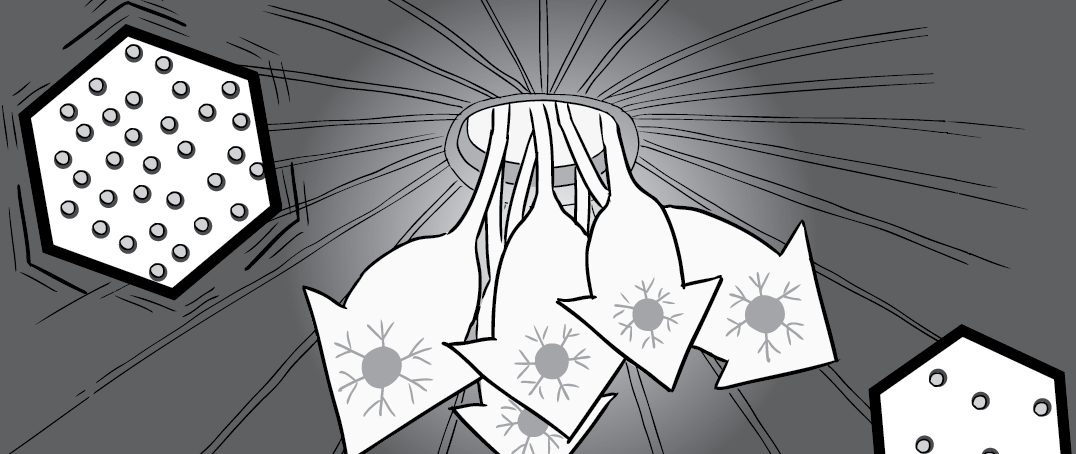
I have just released a new comic entitled Buckminster Fuller’s Chilling Domes.
It is my first comic about one of my true heroes, Buckminster Fuller. I hope to draw many more comics about Bucky throughout my career as a cartoonist.
If you haven’t already done so, please now read my comic Buckminster Fuller’s Chilling Domes, which I will refer to in the rest of this essay.
A forgotten phenomenon
Bucky Fuller was a true polymath, responsible for many, many different ideas and inventions throughout his career.
When people reflect back on Bucky’s career, he is primarily remembered for inventing the geodesic dome: the most structurally-strong, resource-efficient way to enclose a space with a physical structure. Bucky is also remembered for other inventions such as his three-wheeled Dymaxion Vehicle, as well as his prototyped Dymaxion House, which was a spiritual successor to the Dymaxion Deployment Unit that never entered mass-production.
Yet instead of focusing on those well-known Bucky inventions, I decided to focus on one of his “forgotten” discoveries: the self-chilling, zero-energy, passively-cooled dome home.
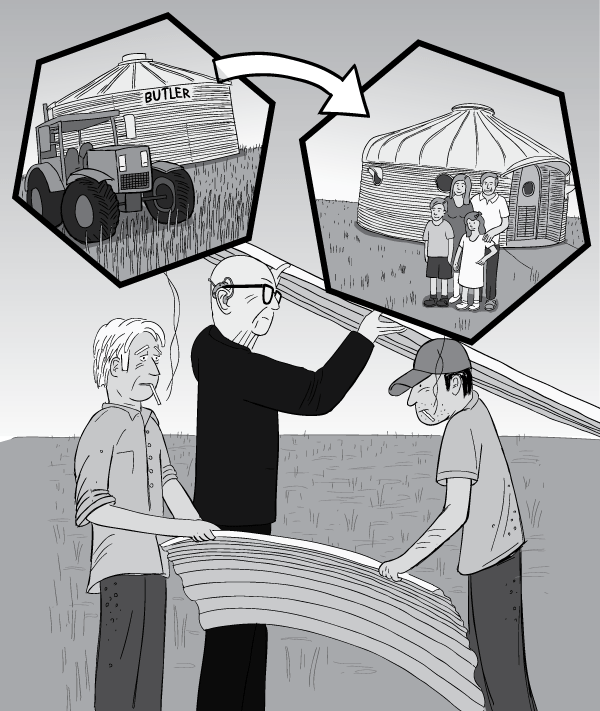
Why I chose to draw about this phenomenon in particular
The reason I drew a comic about Buckminster Fuller’s self-chilling domes is because he personally experienced the phenomenon while constructing the Dymaxion Deployment Unit (DDU) in Kansas during summer 1940.
It was something that physically existed in the real world.
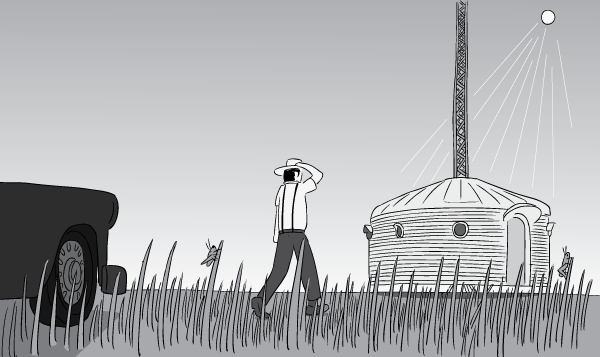
In other words, I chose not to cover one of Bucky’s hypothetical inventions such as the proposed Cloud Nine airborne cities, or his proposed Global Energy Grid, which were never physically built.
Instead, I chose to cover a phenomenon that Bucky Fuller personally experienced in the flesh, along with the other men on the construction site such as Butler Manufacturing president Emanuel E. Norquist.
My references for the Chilling Domes phenomenon
I first learnt about the phenomenon through the following three books:
- Buckminster Fuller’s Universe by L. Steven Sieden (1989; pp208-9)
- BuckyWorks by J. Baldwin (1996; p36 & pp114-17)
- Critical Path by R. Buckminster Fuller (1982; p211)
However, the granddaddy of all sources seems to be the lecture that Buckminster Fuller gave in Philadelphia on 30 January 1975. This was session 10 of his Everything I Know lecture series, in which he attempted to communicate his entire life’s work in spoken format. The series of 12 lectures ended up spanning 42 hours(!)
The lecture exists as text transcript. (Ctrl+F to the phrase “Now, it was August, 1940”, where he begins describing what happened inside the grain silo.).
It also exists as a video, which is probably the best way to experience it, due to Bucky’s extensive use of ‘talking with his hands’ to demonstrate convection currents.
If you want to hear the entire story about that summer day in Kansas, watch the video from clip #142 to #152 (roughly 13 minutes total).
If you don’t have much time, the central part of the story, with him describing the physics is from #145 to #149 (roughly 6 minutes total).
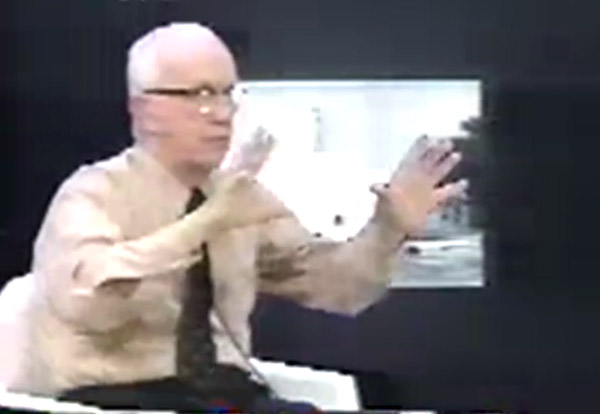
A multitude of terminology
There are a lot of terms associated with this phenomenon. I will mention some of them here:
- The phenomenon is specifically referred to as either “chilling domes” or “chilling machines” by the 3 books by Sieden, Baldwin and Fuller. Others have described the downward air current as a “reverse chimney effect“.
- Broadly speaking, the phenomenon fits into the building design approach of passive cooling, since it is a way that the building sheds heat automatically, without the need for active cooling such as electrically-powered air conditioners.
- Buckminster Fuller himself described the underlying phenomenon as, “Bernoulli’s principle”, with other writers calling it “the Bernoulli effect” or “the venturi effect”.
Unfortunately, as I will soon describe, the explanations of the physics behind this chilling dome phenomenon is often patchy.
Dodgy physics, dodgy explanations
The three books do a good job of describing the airflow phenomenon, but they do a bad job of explaining the phenomenon.
Most explanations stem from Bucky’s own assertion that Bernoulli’s principle is the underlying phenomenon driving the air currents.
Wanting to express the concept as accurately as possible in my comic, I sought input from a physicist friend, Chris Weekes.
Chris helped me to discard some of the dodgy explanations which contravened the laws of physics. For example, Sieden (1989) stated that the air entering the small inlet vent was “compressed” as it entered.
By contrast Chris and I do not believe that the air molecules compressed as they entered the dome through the top vent. This is because air does not have a tendency to move from low-pressure to high-pressure.
Instead of compressing, we think that the explanation is that the air molecules accelerated when they entered the top vent, converting the thermal energy of the warm ambient air into kinetic energy. This is more in line with Baldwin (1996)’s explanation.
However, all writers (Sieden, Baldwin and Fuller) state the Bernoulli principle is the best way to explain the phenomenon. Instead, Chris and I think that acceleration under the principle of conservation of energy; as well as adiabatic expansion, are the best ways to explain it. The Bernoulli principle is involved in what is going on, but there are more generalised ways to explain the phenomenon using more generalised conservation of energy principles, following the first law of thermodynamics.
Why is this chilling dome phenomenon unheard of?
As I publish this comic, it is August 2015. It is now exactly 75 years after Buckminster Fuller described the “chilling dome” effect in Kansas City when building the Dymaxion Deployment Unit prototype in 1940.
Yet, today, as I search the web for information, I can only find one Bucky-related web page dedicated to this phenomenon. And I cannot find reference to the “reverse chimney effect” phenomenon in any of the ‘green architecture’ or ‘passive solar building design’ resources that I have checked.
So why has this principle been ignored?
This is a genuine question that I am raising, as I am keen to know the limitations and drawbacks of the phenomenon.
Possible explanation #1: it is disbelieved, and therefore ignored
Take another look at Buckminster Fuller’s Everything I Know lecture 10, specifically clip #150.
In the clip #150 video Bucky admits that the phenomenon is counter-intuitive, as common sense suggests that warm air would exit through the vent in the top of a dome on a warm summer day.
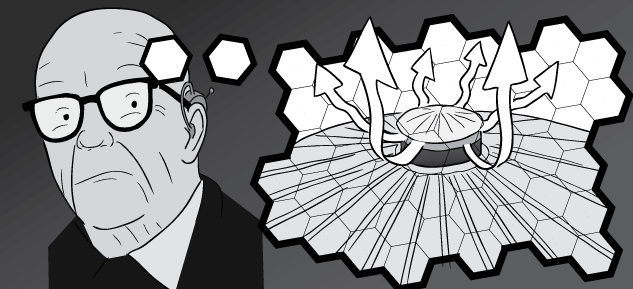
Bucky described householders moving into geodesic dome homes, and installing electric exhaust fans at the top of their domes, attempting to blow the warm out out of the top of the dome. He describes this as being an energy-wasting arm wrestle against the passive forces created by the structure’s natural air flow.
Bucky also says that “air conditioner salesmen are better than I am” in convincing householders to install an electric air conditioning system. He suggests that home occupants are unwilling to risk being caught in the middle of a heat wave, relying on passive cooling methods. So they install active cooling (air conditioners) for peace of mind.
Possible explanation #2: it does work, but is impossible to employ in some cases
The phenomenon, from my understanding, seems to work due to the heat rising from the sunbaked exterior walls of the structure.
Therefore, it would be difficult, perhaps impossible to create the effect if the house was not in direct sunshine. For example, if the house was surrounded by taller buildings, or tall trees that shaded the house. In clip 151, Bucky admits that the phenomenon does not work at night time. Perhaps it also does not work in the shade.
Possible explanation #3: it does work, but operates contrary to the way that people normally use their houses
It is possible that the phenomenon works most effectively if the interior of the house is sheltered from lateral breezes created by opening windows on the walls of the houses.
Building occupants usually have a psychological tendency to cool their living areas by opening doors and windows on the side walls of their house, and creating lateral breezes.
It could be that these lateral breezes interfere with the vertical airflow that this “reverse chimney effect” relies on.
(As a side note, the apertures for cooling module of this nifty sustainable building design workshop suggests that householders can produce a mini version of adiabatic cooling from the lateral breeze that flows through a house. You just need to strategically open your windows so that the windows on the windward side have a smaller size than the windows on the leeward side. If the prevailing wind is strong enough, air will be sucked through your house from the low pressure area on the leeward side of your house. Here is the diagram from that web page, though I can’t personally vouch for it working:)
Possible explanation #4: it does work, but there are superior passive cooling strategies
The phenomenon is driven by solar energy creating thermal updrafts from walls and paved areas surrounding a house.
Therefore, it cold be that other passive cooling strategies hinder Bucky’s effect coming to full fruition. For example, if you installed a green wall or similar external shading systems on the exterior of your building, the solar gain would be blocked or diminished.
Possible explanation #5: it doesn’t work at all
This is another explanation to consider: Bucky was simply telling a lie. Though I personally presume that Buckminster Fuller was telling the truth, especially since he lists specific witnesses such as Butler Manufacturing president Emanuel E. Norquist.
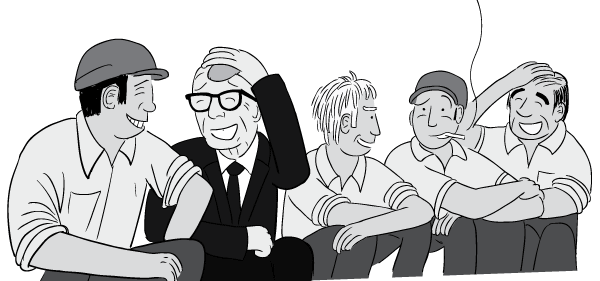
Nevertheless, I did discover this Google Groups forum that claims to have debunked the phenomenon. A user (‘KK’) has posted a message claiming that they have busted the idea of a chilling dome by constructing a scale model that could not reproduce the downward air current through a top vent. Unfortunately the relevant video that the user refers to has be removed from YouTube, so we can no longer see the footage.
Time for more research and development
As I mentioned towards the start of this article, there is currently almost zero information currently on the web recommending the “reverse chimney effect” as an effective passive cooling option.
Yet, if it does work, it seems like it would be an energy-saving technology that would be able to slash energy bills and fossil fuel consumption. Imagine if, for example, server farms could be housed in buildings designed to passively cool using this reverse chimney effect / adiabatic expansion. I’m sure that supplemental energy would still be needed to ensure that the servers are always chilled to the appropriate temperature. But perhaps passive airflow could perform the brunt of the work without the need for energy. This is just a thought bubble on my part.
I encourage builders, designers, and home owners to test this phenomenon and share the results with the internet at large. Perhaps via the ‘comments’ section below.
A call for patrons
Did you enjoy your reading experience? Did I teach you something new about Buckminster Fuller’s chilling dome discovery?
If so, please become a recurring monthly supporter via crowdfundstu.com. I spent roughly 120 hours on this comic, as well as the associated research, fact-checking, physics-checking and blog post-writing.
If you liked Buckminster Fuller’s Chilling Domes, you will surely enjoy the future comics that I am constantly creating. Please ‘pay it forward’:











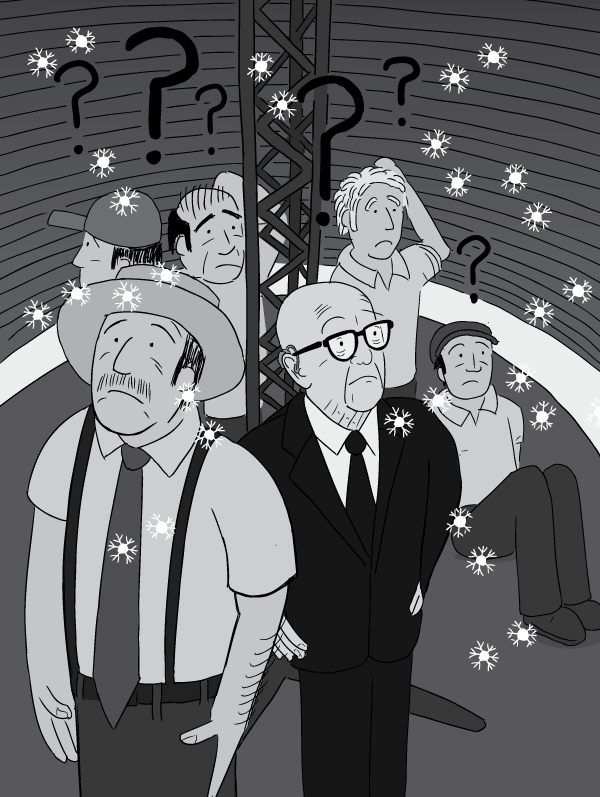

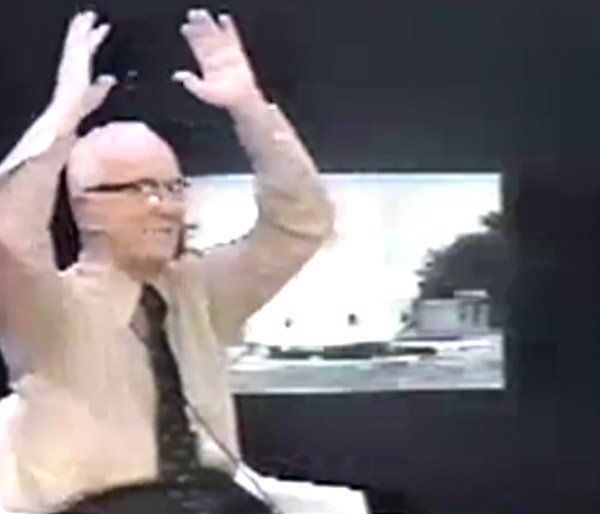
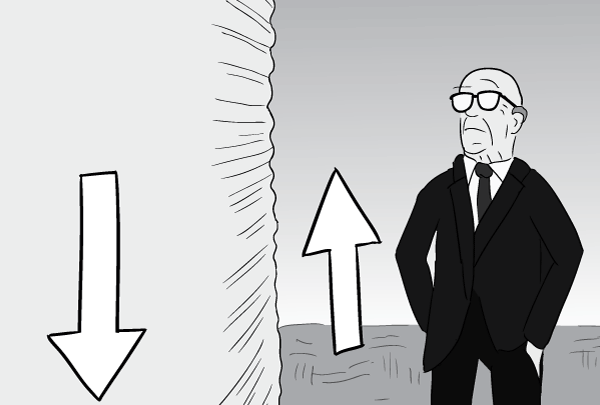
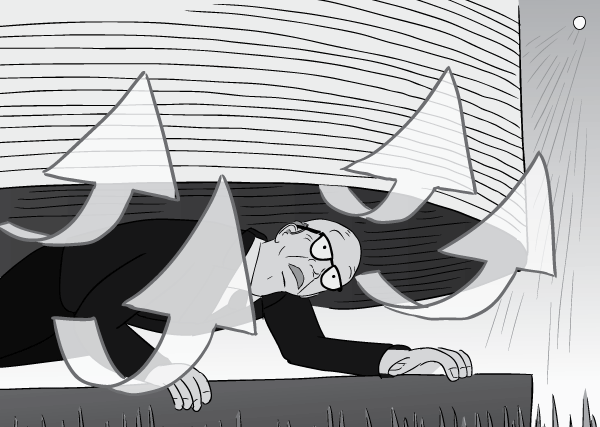
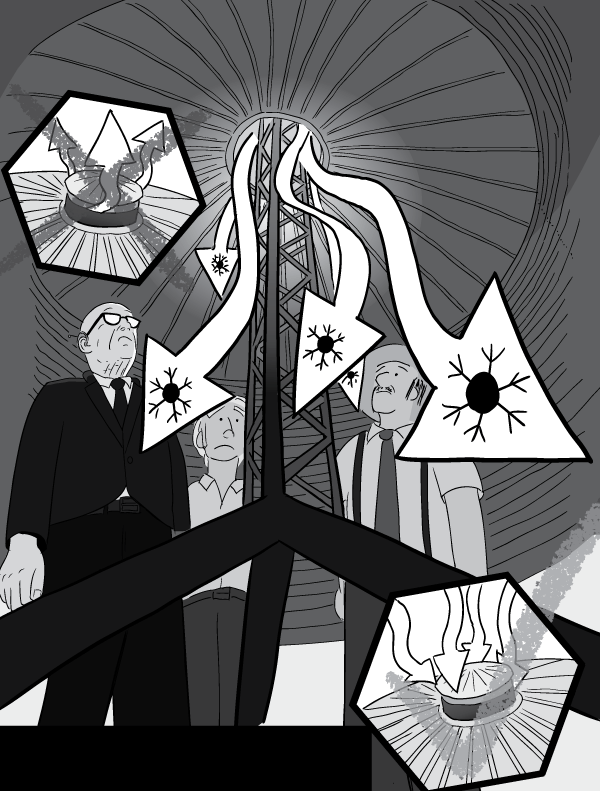
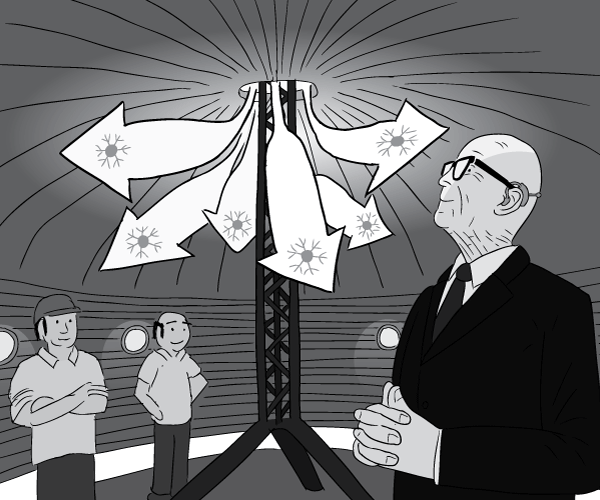
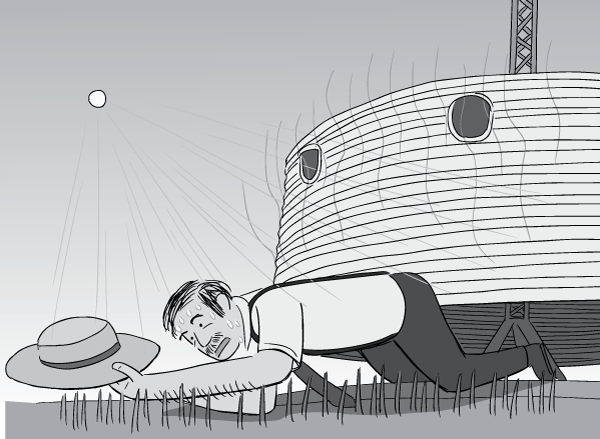
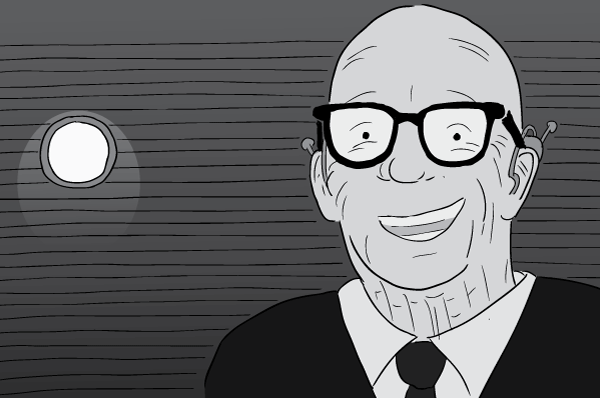
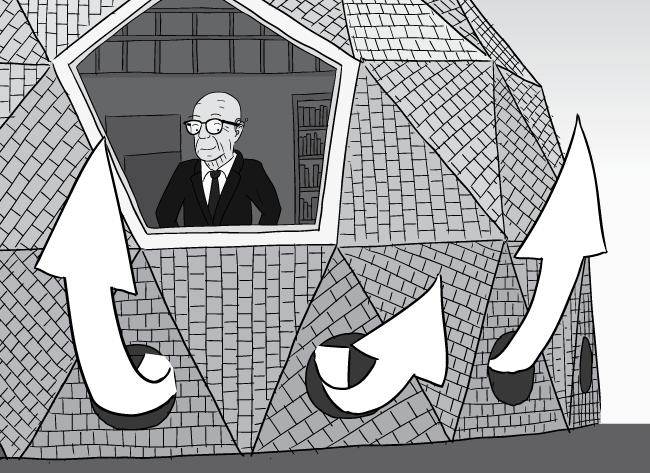
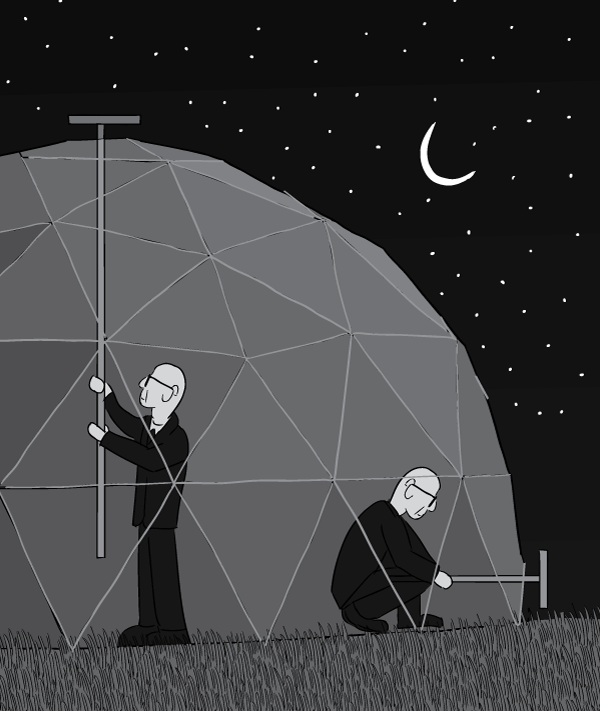
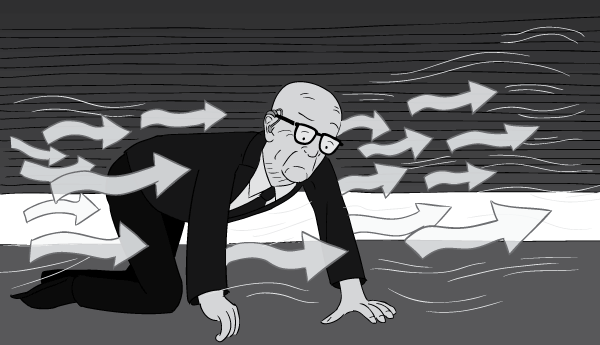
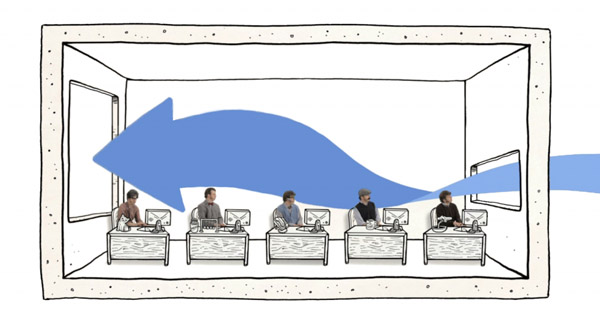
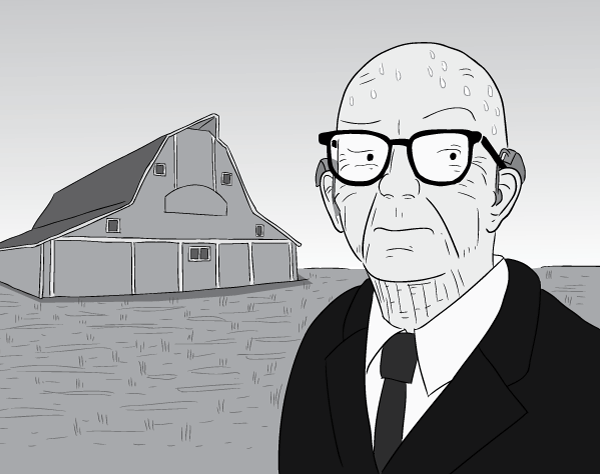
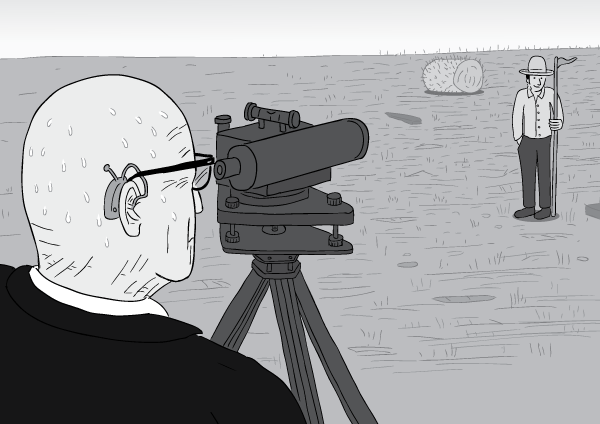
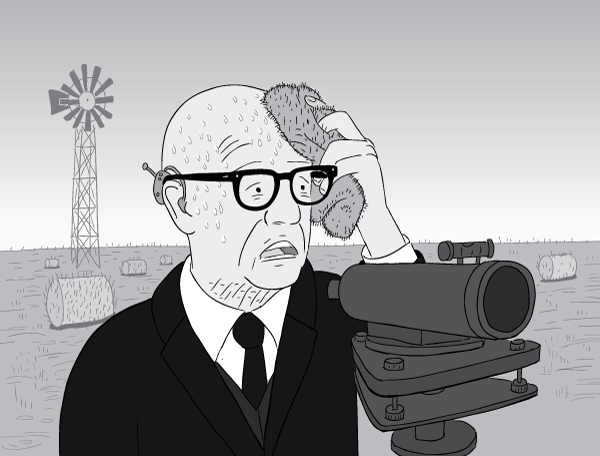
Comments
Andy
I came across this today by way of your St Matthew Island comic. Your work is excellent, and communicates politicized concepts in ways that might break through some people's defenses (though I share your positions on science and climate already, so I could be wrong). I hadn't encountered this story about Bucky's accidental adiabatic cooling discovery before, but was reminded of something else I encountered recently, which is almost the inverse, but still takes advantage of passive physics and dome structures to achieve cooling without modern power or cooling technology: https://en.wikipedia.org/wiki/Yakhch%C4%81l https://misfitsarchitecture.com/2013/02/22/its-not-rocket-science-2-yakhchal/
Crash
Very interesting. I am no engineer, but I believe this concept would only work well at certain size. An earlier commenter has already mentioned the surface area versus volume problem... Since it wont work at night or when shaded, it wont become a standard of building, however it seems to me that one could use this concept on small scale situations and as a step in multistep cooling arrangement. Your research is well done, and well described for us laymen, thank you for your efforts! Any chance you might work on the concept of using Bucky balls and Bucky cylinders to maintain pressures on superconducting compounds, to maintain required pressures at room temperature? Thanks for all your work, Sir - Crash
Edward Lye
Well done. Like the British Hydrautomat, these warrant further investigation. https://en.wikipedia.org/wiki/Angelo_Di_Pietro_(inventor) https://www.engineair.com.au/ https://www.youtube.com/watch?v=xwQpgG7Ii3A When I last visited Melbourne, I was unaware that the company was located at the outskirts of Melbourne. I am unlikely to travel to Australia in the rest of my lifetime. I asked my neighbour who is a permanent resident to visit this company on my behalf. She said she would do so after she passed her driving licence. The last I heard, it is too difficult to pass and she is recently recovering from cancer or somethiong else. If you are on the lookout for the next mission, here it is. Bill Mollison talked about Ragged Chutes. It makes cold dry compressed air out of falling water. The dryness makes this ideal for compressed air motors since you have less formation of ice in the engine. Besides the air compression involves no moving parts. How extraordinary. I understand there is a similar thingy in Western Australia. I forget where. I did my research decades ago. The internet is no longer what it used to be. Ragged chutes has a water fall of 107m. I reckon the rain runoff from the roof of 38-storey building is equivalent to Ragged Chutes. An abandoned building, enough pipes, a buried chamber and a good storm can make for a good project for an aspiring undergraduate in engineering. https://www.aetherforce.energy/ragged-chutes-the-power-of-compressed-air/ Lastly, I suggest you contact James Dyson to extend his annual contest for the Fuller Self-Chilling Dome. Air bending is his unsurpassed speciality. There is no penalty in suggesting this. https://www.jamesdysonaward.org/en-MY/ I admire your enthusiasm. I suggested that the British Hydrautomat deserves further investigation. A cascade of these beside a pumped storage hydroelectric dam can replenish some of the water. It only has one moving part. Imagine a ferris wheel very close to a building. A man steps into a pod at 9 o'clock and a slightly heavier man steps in at 3 o'clock. The wheel will turn. For free, the 3 o'clock reaches the ground floor while the 9 o'clock reaches the roof. This, in essesce, is how the Hydrautomat works. You will never get 50 percent returns but close to that. A pyramidal network will recover some of the energy that is now completely wasted. I like free.
Ashley Phillips
I am part of the Design Science Studio project part of the Buckminster Fuller Institute. #TouchedMovedAndInspired by your zeene. Fantastic work linktr.ee/ashleyphillips.art
Blair Wolfram
The effect of Buckminster Fuller's Chilling Machine: The sun facing side of the building is black, creating heat and convection on the roof of the dome. This warmed roof surface air rises into the atmosphere and draws air from below to replace it. Short wide openings at the base of the dome allow air to be drawn out of the dome and convect up the outside of the dome towards the heat. This larger mass of air is drawn out of the dome and only a small amount of air is allowed in. If the sun facing side of the dome has 25 square feet of exhaust opening, and at the top of the dome 1 square foot of air is allowed to enter, the negative air pressure inside the dome will suck air in. (Like how a carburetor uses negative air pressure from cylinder exhaust to suck fuel in.) Air will expand as it is drawn into the negative dome pressure. When air expands, it cools. If you wide open the valve on an air compressor and let the air escape in a blast stream, the valve will develop a coating of frost. This is caused by air rapidly expanding and cooling. This cooling system should work most efficiently on the hottest sunniest days. Blair
Julie
morming. I'm definitely a Bucky fan. Am Renovating a 9.5 metre diameter geodesic dome in Upper Main Arm. Near Byron bay. I would live to talk to you about these ideas of warming and cooling as now is the time for me to implement these principles. And would certainly support your work if these ideas can help with the eco renovation of this beautiful old girl which was built in the early 70's and been derelict for over 30 years. Hope to hear from you soon. Cheers. Julie.
Greg Tolnai
Hello, I ve been living in a tipi since last year with my family... its great and manageable aerodynamicly. This winter my partner complained of lack of space so i made a v3 metal bar geodome 21ft diameter. Its always dripping. /condensation on metal bars / i tried to make open fire like in a tipi but it seams the smoke just does not want to leave the dome. It really still like giant floating spider webs. As temperature rise inside the smoke comes further down in tipi but the bottom 1 feet usually smoke free. I ve made relative succes of getting rid of smoke by using a ricket stove under the hole above it but smoke only clears when its on full blast. I ve noticed through observing flying ashes that there is a tight boundary between up current and down current. There is a tiny dead zone in between where smoke ashes still / mixing. I want to heat it up and keep humidity level down. Is anyone can adress these issues? Please contact me on [email protected] I m looking forward to exchange experiences and knowledge. Also happy to test , proof ,disproof theories. Cheers Greg
Adam B Fuller
I bet this effect also depends strongly on the nature of the material making up the dome and other details of what's going on in the dome. Essentially, as described it requires the air _outside_ the dome to be heated and rise, pulling air out around the base. But if there's a heat source inside the dome (equipment, sunlight coming in through windows, heat being transmitted through the walls) then the air inside the dome will be heated by those sources and rise, counteracting the inflow from the top and spoiling the effect.
Nolan Brown
The Tombstone courthouse in Arizona has a central top vent. The air flow in the courthouse come in through an open window and out the top vent. The air does not flow in from the vent and out the windows.
Todd Millions
And so I come to the point you mentioned but needs I think some Emphasis- Both the colour insulation and size affects the cooling performance. Fuller was able to increase the draw out the lower vents by using darker colours towards the base.Transparent domes(sic:J Baldwin Biodome) only cool to outside air temps with the vents set for cooling. The insulation levels in the shell That optimize heating and cooling(R-12 in the Butler bin conversions),is lessened as diameter increases. This is due to the Volume to surface ratio.Which B.Fuller understood very well. And explained with unusual effectiveness. Which would be an excellent subject for another comic(hint hint)-riffs on Galileo usually are. Cheers &Bon Chance Todd Millions
Todd Millions
Frame 4: Quibble(tractor)-To emphasis time & place(useful to show how long this has being available),you may want to consider changing the tractor to one I have a fondness for a -1938 Minneapolis Moline UDLX "Comfortractor".A noble beast of right vintage.It was designed to replace the car with an expensive tractor. Better though out than the modern tonka for tards truck but the 70kmh road speed was a tad too high for the suspension.50kmh it was fine on a good road. Frame 4-Amplification 'Conversion' of Bin-I think "by mainly new roof and insulation lining"if the space is available.
Todd Millions
Mr. McMillen- Hello .I just did a perusal of your comic on self-chilling domes.Finding it well done I checked your blog.You seem to have an amusing spell check issue with you last name, I say amusing as I oft have the same and also have problems with proper received spelling vis the degenerate yankydom version.I tend to go with however when posting as there are already enough and sometimes, suspect problems with machine translations otherwise. I have some comments & quibbles with this comic but its well done so I'll comment seperately on them -This is an imprtant subject,you have done it well but clarifications may make it more effective. You have the wit to know why and that efforts for undestanding and deployment are being sabotaged. Cheers -Todd Millions bx712EastendSKsonotoCanada
organic planting
I got this web page from my friend who shared with me about this website and at the moment this time I am visiting this web page and reading very informative articles or reviews at this place.